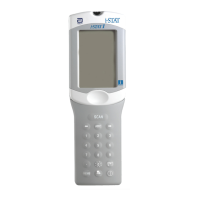20-4 Art: 714382-00D Rev. Date: 02/20/06
Activity Versus
Concentration
Ion-selective electrodes measure activity rather than concentration. Activity (a)
is related to concentration (c) through the activity coefficient (γ): a = γc.
While ion activities, which reflect free rather than total ion concentrations,
are the physiologically relevant quantity, activity values are converted to
conventional concentration units so that values obtained by direct ISE
measurements can be compared to values obtained from methods that measure
total ion concentrations. The latter includes the indirect methods, which
have activity coefficients close to unity or one, and flame photometric, atomic
absorption and titration methods.
Amperometric
Sensors
In amperometric measurements, a potential is applied to the measuring
electrode while current generated by the resulting oxidation or reduction
reactions in the test system is measured. The current generated is directly
proportional to the concentration of the analyte. An enzyme can be added to a
layer on or near an amperometric sensor to produce electroactive species from
analytes of interest that cannot themselves be oxidized or reduced.
Conductometric
Sensors
In a conductometric measurement, an alternating current is applied between
two electrodes in contact with the test solution and the resulting voltage
difference is measured. The conductivity of the solution is proportional to
the magnitude of the voltage difference. In aqueous solutions, conductivity is
dependent upon the concentration of electrolytes; an increase in the electrolyte
concentration causes an increase in conductivity.
Where S replaces the constant term which defines the slope of the sensor.
The slope is the change in millivolts per tenfold change in the activity of the
analyte. For a positively-charged monovalent ion, the theoretical slope would
be 59.1 mV at 25°C.
DETERMINATION OF TEST RESULTS
Determination
of Analyte
Concentration
Potentiometric and amperometric sensors are used for the determination of
analyte concentration. For both sensors, the concentration of the analyte
can be calculated using:
1) the known value of the analyte concentration in the calibrant
solution,
2) the measured voltage (potentiometric) or current (amperometric)
signal generated by the analyte in the calibrant, and
3) the measured signal generated by the analyte in the test solution.
For potentiometric sensors, the analyte activity in the sample is calculated from
the Nernst equation according to:
E
sample
- E
calibrant
= S log (a
sample
/a
calibrant
).
Complex solutions such as blood deviate slightly from Nernstian behavior due
to interfering ions and matrix effects that result in junction potentials. By
including selectivity coefficients in the Nernst equation (Nikolsky equation),
these effects can be minimized. By characterizing the reference electrode in
different solutions, effects of matrix on the reference junction potential can
also be minimized.

